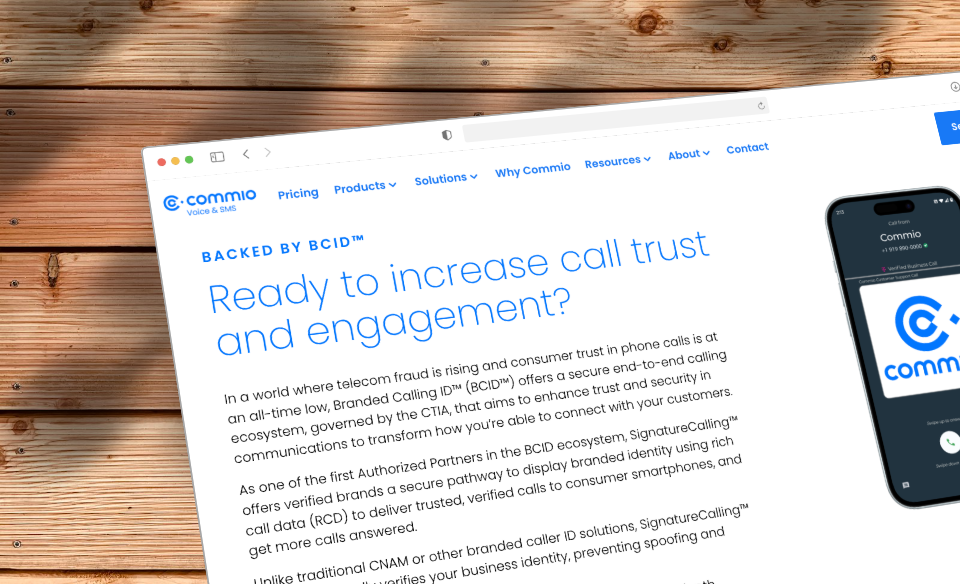The Right Voice Options to Protect & Grow Your Business
Before cloud communications came along, phone service was basically “one of everything.” You had one provider doing everything, for better or for worse, with little to no customization. Calls were sometimes static-y and sometimes they didn’t go through at all, but it was what it was.
These days you have all sorts of providers to choose from. You can pick outbound (“termination”) calling and/or inbound (“origination”) calling, delivered domestically, internationally, or via toll-free. You can use different providers for each. The variety of features can vary from one provider to the next, and everything works together, so you can use a platform like Twilio, Nexmo, or SignalWire to build a platform and handle your calls, then plug in a carrier solution to deliver your dials (like Commio) to get the best of both worlds. (It takes just seconds to add – ask for a demo.)
All of the options are, well, confusing – even for those of us in the business! For starters, doesn’t inbound/outbound depend on whether you’re making or receiving the calls? Doesn’t every phone number make and receive calls? And why would I need 40+ carriers?!
Taking a few minutes to understand the terms and their differences can help you tailor your calling package to best fit your enterprise or SaaS organization, while improving your margins and your competitive position.
Some Critical Calling Features
Whether your company’s calling is mainly inbound or outbound – or your software as a service includes voice communication capabilities – clear, crisp calls that always connect are top priority. These days, it’s an integral part of the customer experience. However, call quality and deliverability depends on your choice of providers and the features they offer, how they’re configured, and your geographic location (plus the geographic location of the other person on the call).
All providers are not created equal! Some key features include:
- Intelligent Call Routing (ICR) – Gotta love automation! ICR (known by some as Least Cost Routing, or LCR) is when a provider uses software to determine the best priced route for your calls across multiple carriers. Most providers offer some version. Only Commio uses machine learning to find the routes that are both economical and the highest quality. If scalability is important to your company, you need least cost routing at a minimum. If customer experience is important, you also want smarter call routing.
- Redundancy – aka, the number of carriers a provider uses. This is critical for many reasons, including price and scalability; the size of the footprint (i.e., geographic coverage and number availability); and most importantly call quality and deliverability. Commio, for example, uses 40+ carriers. This is a critical component of disaster recovery. See below, or learn more here.
- Disaster Recovery – All calls travel through a variety of carriers, and if one goes down, it can affect any number of your calls, depending on location. If a large one goes down, it affects a lot of them. If your provider uses just one (or is their own carrier) and they go down, you’re in trouble. Even an hour of downtime can be cost prohibitive to a call center. Fortunately most or all providers and carriers have systems in place to limit these (generally proprietary information, but you can ask). However, more carrier options always reduces your risk, as do multiple physical (vs. virtual) data centers.
- Footprint and Number Availability – Footprint essentially refers to a provider’s geographic coverage. Commio, for example, covers 95% of the +1 area (i.e., most of North America). This means higher quality calls from more places, but also more number availability in those places and greater ease acquiring them.
- Transparency and Control – Very few providers let you see how your calls are routed – let alone let you take control of those routes – but if a call center is a critical part of your business, you should seriously consider this option. Although Commio automatically sends your calls via the best and lowest cost route, you have the option to change carriers in real-time, allowing you to circumvent outages almost instantaneously. Learn more here.
Other Considerations / Limitations
If not all providers are created equal, neither are all networks. You’ll hear a lot of talk about ILECs and CLECs, virtual and internet vs. copper and landlines, proprietary networks, aggregators, blah blah blah. A lot of the information seems intended to confuse, but basically it’s all around how a network is designed, and it’s important in that it affects the features a provider can offer, how much they’ll cost, and the risks of an outage.
A single carrier provider has total control over their network, but also assumes all of the overhead and probably has a smaller calling footprint; obviously, there is no redundancy and fewer disaster recovery options. An aggregator utilizes several carriers (they might or might not be willing to share which ones), which minimizes overhead but also reduces the control, and adds to redundancy. A Virtual Local Exchange Carrier, or VLEC, offers the best of both worlds but is harder to find (Commio is one).
Which is best for your needs? Ask each provider how their network is set up and what they see as the advantages and disadvantages. You can also get some indication by the features they provide. If they have no redundancy, for example, they’re a single carrier provider.
A couple other aspects of cloud communications that might be important to your organization are STIR-SHAKEN and fraud control measures, as well as customer support. Although every provider offers these, the levels can vary. You might also consider looking at provider reviews on G2.com for independent verification.
 Inbound, Outbound, or Toll-Free?
Inbound, Outbound, or Toll-Free?
Some companies make a lot more calls than they receive, whereas others mostly receive calls. For example, a support center that answers questions, takes orders, handles returns, etc., primarily needs inbound calling. If you want to make it easy for customers to call you – including calling for free – you want toll-free service. If your company does telemarketing and cold calling for sales, chances are outbound voice services will meet the majority of your needs. (And yes, technically any phone with inbound or outbound calling can do the reverse – the numbers still work both ways.)
The category that best describes your company, along with your budget and risk tolerance, will help determine the features you need and what you should look for in a provider. You might need both inbound and outbound services, and prefer to deal with a single provider. (The good news is, unlike some areas of life, there isn’t a direct correlation between cost and quality; you don’t need to pay an arm and a leg for great service!)
Although choosing the right provider for outbound is important for call quality and deliverability, it’s easier than inbound. There are more to choose from, selecting phone numbers is mostly irrelevant, and it’s super easy to switch from one provider to another (of course you’ll still want to ask them about redundancy, disaster recovery, etc.).
Toll-free voice utilizes less carriers and you’ll need to get phone number(s) – which can be tricky if you want your number branded (for example, 1-800-FLOWERS) – but it’s still easier than “local” inbound because of the way toll-free numbers are administered on a national basis. For similar reasons, it’s relatively easy for a provider to offer toll-free redundancy if they utilize multiple carriers and are configured to support it. (Commio offers toll-free transparency and control to the customer.)
Inbound is the most complicated, with the least number of major carriers and a great deal of complexity around acquiring phone numbers because they have to be “locally” obtained from a bazillion different sources. Providers with a small footprint can take a lot longer to acquire numbers. As you might guess, having so many sources also complicates redundancy, which is moving a number between carriers but also essentially moving a number from one source to another. Last but not least, while outbound providers can be changed in a matter of minutes, inbound voice takes some work to set up when you switch.
For these reasons, if inbound calling is a core part of your business you’ll want a provider who handles a lot of inbound traffic, has a large footprint, and has a network specifically set up to handle inbound redundancy. (To learn more about how Commio handles inbound calling, register for our webinar<link> on June 23, 2022!)
* * * * *
Bottom line: you don’t have to know every acronym in telecommunications or understand the in’s and outs of how a provider’s network can be configured. But, you do need to know the importance of inbound vs. outbound voice traffic, whether having a toll-free number makes sense, and how critical calling is to your organization. If losing even an hour or two of business could cause major damage to your profit margin or your bottom line, then you need to know the basics described above and choose your providers carefully.

 Inbound, Outbound, or Toll-Free?
Inbound, Outbound, or Toll-Free?













